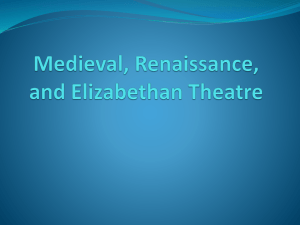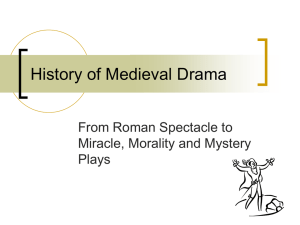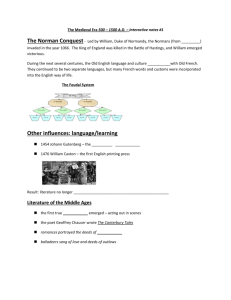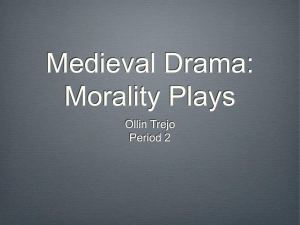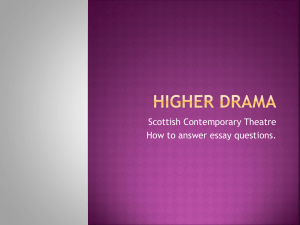Medieval Theatre Handout - utk-ma-comp
advertisement
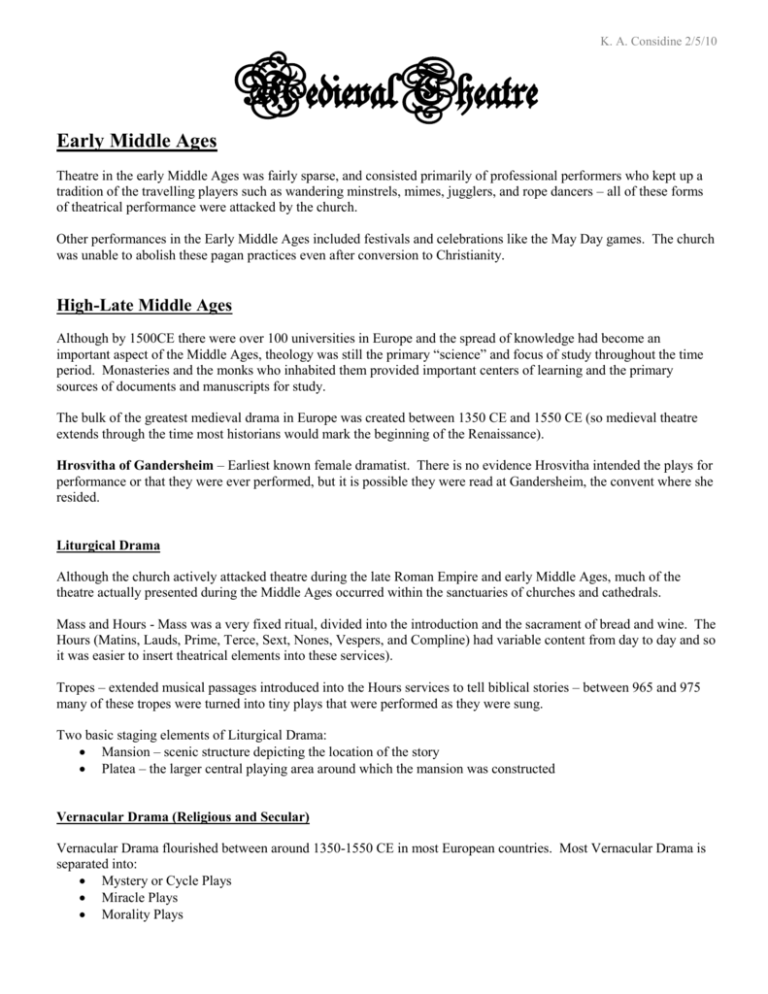
K. A. Considine 2/5/10 Medieval Theatre Early Middle Ages Theatre in the early Middle Ages was fairly sparse, and consisted primarily of professional performers who kept up a tradition of the travelling players such as wandering minstrels, mimes, jugglers, and rope dancers – all of these forms of theatrical performance were attacked by the church. Other performances in the Early Middle Ages included festivals and celebrations like the May Day games. The church was unable to abolish these pagan practices even after conversion to Christianity. High-Late Middle Ages Although by 1500CE there were over 100 universities in Europe and the spread of knowledge had become an important aspect of the Middle Ages, theology was still the primary “science” and focus of study throughout the time period. Monasteries and the monks who inhabited them provided important centers of learning and the primary sources of documents and manuscripts for study. The bulk of the greatest medieval drama in Europe was created between 1350 CE and 1550 CE (so medieval theatre extends through the time most historians would mark the beginning of the Renaissance). Hrosvitha of Gandersheim – Earliest known female dramatist. There is no evidence Hrosvitha intended the plays for performance or that they were ever performed, but it is possible they were read at Gandersheim, the convent where she resided. Liturgical Drama Although the church actively attacked theatre during the late Roman Empire and early Middle Ages, much of the theatre actually presented during the Middle Ages occurred within the sanctuaries of churches and cathedrals. Mass and Hours - Mass was a very fixed ritual, divided into the introduction and the sacrament of bread and wine. The Hours (Matins, Lauds, Prime, Terce, Sext, Nones, Vespers, and Compline) had variable content from day to day and so it was easier to insert theatrical elements into these services). Tropes – extended musical passages introduced into the Hours services to tell biblical stories – between 965 and 975 many of these tropes were turned into tiny plays that were performed as they were sung. Two basic staging elements of Liturgical Drama: Mansion – scenic structure depicting the location of the story Platea – the larger central playing area around which the mansion was constructed Vernacular Drama (Religious and Secular) Vernacular Drama flourished between around 1350-1550 CE in most European countries. Most Vernacular Drama is separated into: Mystery or Cycle Plays Miracle Plays Morality Plays Mystery or Cycle Plays The term mystery here comes from ministerium, indicating a religious service or office and suggesting the religious origin of these plays. The plays dramatize a series of biblical events, from creation to the last judgment. They differed from the Liturgical Drama in that they were not presented in the church or as part of a religious ceremony, and that they were not individual scenes but short pieces presented as part of a sequence. When a number of these short plays were presented in sequence they constituted a cycle – the origin of the term “Cycle Plays.” Mystery Plays were written to appeal to large audiences and popular tastes, and so while the mysteries are biblical stories, the characters are medieval types (for example, Abraham and Isaac are dramatized as medieval Christian serfs rather than Old Testament Jews). Mystery Plays often included other anachronisms such as characters speaking of saints that hadn’t been born in their time. Other devices used to appeal to mass audiences include uses of stagecraft to provide spectacle (such as having water rain on the stage during the flood while Noah and his family remain safe) and comedy. The Second Shepherd’s Play (ca. 1375) from England’s Wakefield Cycle The English mystery plays are grouped in a series of cycles and named after the places where they were performed, so the Wakefield cycle means it was performed in Wakefield. The Second Shepherd’s Play has two distinct sections. In the first section, three shepherds are talking in the fields, when they are joined by Mac. Mac tricks the shepherds and steals a sheep, taking it home to his wife, Gill. When the shepherds come looking for the sheep, Gill puts the sheep in a crib and lays beside it, pretending she has been in labour all night and that the sheep is her baby. The shepherds are almost convinced but figure out at the last minute they are lying and discover that the infant is really their lost sheep. They punish Mac by “tossing him” (this is further explained in other texts as tossing him in the air in a blanket). Theft was a capital offence in medieval law, so the shepherds are being lenient. In the second section, the shepherds are called by the angel of God to visit the new-born Christ child, and they go to Bethlehem to the stable and bring him gifts. Rather than frankincense, gold, and myrrh, they bring cherries, a bird, and a ball to play with. These two sections highlight several parallels – the lost/stolen sheep and the baby Jesus, the shepherds give gifts in both (in the first by attempting to give the child sixpence they discover the deception), the deceitful and cunning Gill and the virginal and good Mary, the three shepherds as the three wise men, etc. Like most medieval vernacular plays it is written in the vernacular and verse and is filled with anachronisms (the shepherds are characters from the middle ages – not biblical times – they complain about their lords and feudal conditions, and they pray to Christ in the first section – before he is “born”). The first section is meant to be comical and farcical, and is much longer than the second section showing the influence of secular farce and the comic and serious elements blend the two types of medieval theatre – religious and secular. Episodic Form: While the episodic form was still in its infancy in the middle ages, there was a marked shift from the crisis form of earlier Greek and Roman theatre toward the Episodic form. Pageant Master: As productions grew more complex, a position developed to help sort out the details of the cycle plays. The pageant master was traditionally the person who organized and oversaw the entire production, probably including the supervision of advance preparation of both the rehearsals and plays and the wagons on which the plays were performed. Production of the Mystery/Cycle Play: Usually Cycle plays were produced every 2-10 years, and were often very elaborate and intense in terms of complexity. The actors in the cycle plays were amateurs for the most part, although professionals may have supplemented the cast as the cycle plays grew more complex and popular. Two types of Stages: Processional: Primarily used by the English, Spanish, and Dutch. The audience would gather in different places and the pageant would be set up on a wagon that would move from place to place so that the play could be performed for each audience Stationary: Predominant in Europe. Usually involved a series of mansions set side by side around a large platform stage. These were usually outdoors, but on occasion small indoor stages were used. Sometimes existing sites were used for the setting. Usually the mansions representing heaven and hell were the most impressive and placed at opposite ends of the stage. In between these two were the lesser mansions depicting earthly locales. Secrets Master: During this time, special effects were tremendously important. The special effects were called secrets, and most productions hired a ‘secrets master’ to oversee them. Effects such as rain on stage, flying the actors, trapdoors, parts of the stage that could be raised or lowered, mirrors used to reflect light and make someone look as though they had a halo are just a few of the special effects used at the time. Miracle Plays Miracle Plays were similar to Mystery Plays, but instead of biblical tales, Miracle Plays were about the lives of saints. Some scholars do not distinguish between Mystery and Miracle Plays (since the subject matter is really the only major distinction), and until 1700 ‘miracle’ was used to describe all medieval theatre. In 1700 miracle became used to specifically denote plays staged on the feast-day of a saint honoring his or her feats. The most popular subjects were the Virgin Mary and Saint Nicholas, and in England Saint George. Morality Plays The morality play attempts to teach a moral lesson through the use of allegorical characters. The characters usually represent ideas, and one or more of the characters often undertakes a journey through which he learns a moral lesson (think Faerie Queen). Sometimes these plays are also called station dramas, since during the journey the character is usually confronted by a series of crises that are similar to the “stations of the cross.” While the Morality Plays are not stories from the bible and the characters are often ordinary men and women, they are rooted in Christianity and moral issues. Because of this, some scholars debate over whether to categorize them as religious or secular. One significant theme that emerged here that would be re-visited heavily in the Renaissance is the struggle between good and evil (say of Satan and God, or an angel and demon) over a person’s soul. Everyman (end of the 15th century) Probably the most popular (almost certainly the most well-known) example of a Morality Play. In Everyman, God becomes angry because men are living lives of sin, concerned only with earthly wealth and pleasures, and no longer respect the sacrifice of God’s only son on the cross. God decides to punish Everyman for his/their sins, and summons Death to aid him. Death find Everyman (representing humanity), and tells him that he will die for his sins. Everyman is unprepared for Death and is afraid, so he looks for a companion for his journey. He asks several characters he thought were faithful friends – Fellowship, Kindred and Cousin, Goods – but they all betray him. He goes then to his Good-Deeds, who says she would go with him, but she is too weak to walk or even stand up. She sends him to her sister, Knowledge. Knowledge guides Everyman to Confession who sets Everyman penance. After this, Good-Deeds can walk and vows to go with Everyman. Everyman also meets Discretion, Strength, his Five-wits, and Beauty. Knowledge then sends Everyman to a priest to receive his sacraments (and there is an interesting discussion on the dangers of priests abusing their position, and the necessity of confirming that the priest is dutiful to God). Everyman follows this advice and receives ‘redemption.’ At first it seems all of these characters will go with Everyman, but eventually, one by one, they all forsake him, first Beauty, then Strength, then Discretion, then his Fivewits. Knowledge goes with Everyman and Good-Deeds all the way to Death’s thresh-hold, but also cannot follow Everyman to the grave. In the end it is only Good-Deeds that can accompany Everyman after Death (the moral of the play). Production of the Morality Play By the early 16th century it is likely that the Morality Plays were produced and performed by professional performers (unlike the Mystery or Miracle Plays). It is also likely that staging was similar to that of the Mystery and Miracle Plays – based on the concept of a neutral staging ground. Secular Drama As the Liturgical Drama and religious Mystery and Miracle Plays were being performed, so too were secular dramas that were often comic and sometimes irreverent. Two popular forms of Secular Drama: Folk plays – dramatizing the exploits of folk heroes Farce – comical depiction of universal human weaknesses Other types of Secular Theatre: Sottie – French cousin of the farce, usually involved a fool as the central figure and was critical of the church or religious figures Interlude – Short, dramatic piece staged between the courses of a meal Street Pageants – usually pantomimed tableaux staged along town routes often to honor visiting monarchs The Epic Battle: Religious vs. Secular Theatre The battle between the religious and secular forms of drama developed slowly throughout the Middle Ages and led to an “explosion” in the Renaissance. All of this culminates and then wanes with the weakening of the church in the 16th century and the Protestant Reformation. Roman Catholicism withdrew its support of religious theatre, blaming it for the weakening of the church (religious drama outlawed in Paris in 1548). Protestantism considered religious drama a tool of Catholicism and so Queen Elizabeth I banned religious theatre in 1559. Although religion and morality was still often a topic for theatrical performance and remains an important spiritual experience for some audiences even today, after the Middle Ages religion was no longer the central concern of most theatre. Sources: Brockett, Oscar G. and Franklin J. Hildy. History of the Theatre. Eighth Ed. Boston: Allyn & Bacon, 1999. Print. “Everyman.” Everyman and Other Interludes. London: J.M. Dent & Sons, Ltd., 1950. Print. “The Wakefield Second Shepherd’s Play.” Everyman and Other Interludes. London: J.M. Dent & Sons, Ltd., 1950. Print. Wilson, Edwin and Alvin Goldfarb. Living Theatre: A History. Third Ed. Boston: McGraw Hill, 2000. Print.
